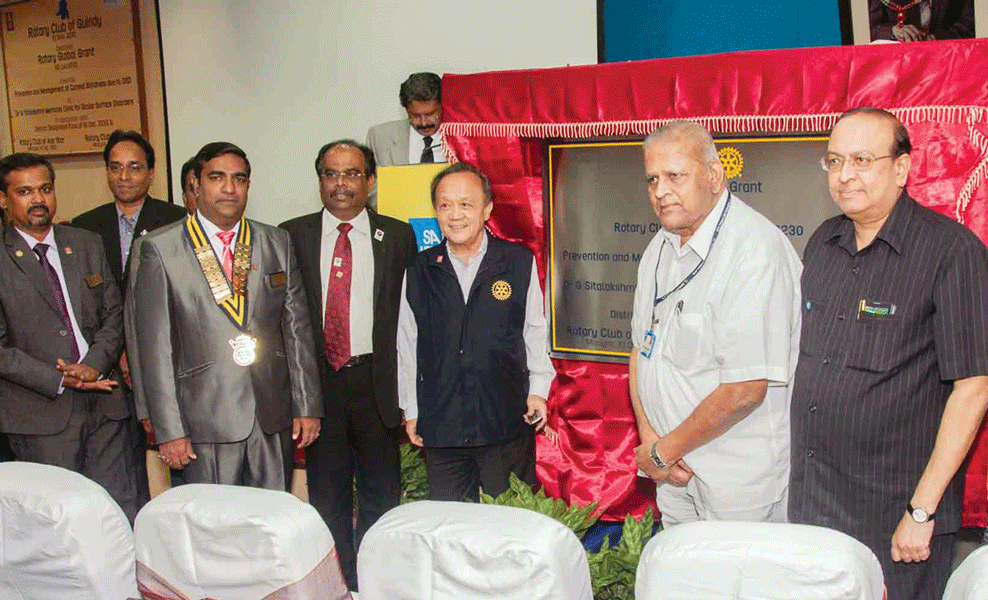
A high school girl whose studies were suddenly disturbed because her vision was affected, a boy who was sent to buy a packet of chuna by his father, and the badly packaged deadly substance burnt his eye when he carelessly tossed it in the air, as children are wont to do, a woman who lost her vision when acid was thrown on her face. Such accidents are endless.
Add to this the chronic dry eye disorder suffered by IT and other professionals who have to stare at their computer screens for long hours. All of them are victims of a serious eye disorder called the ocular surface disorder (OSD). The first three victims all came from poor or lower middle class families and underwent a number of procedures and operations at the Sankara Nethralaya in Chennai to get their vision restored. And all this without spending any money. The woman who was so cruelly treated by her own husband said: “I was given not only free treatment but also food and accommodation during the several trips I had to make to Chennai from my village.”
To provide equipment necessary for research and treatment of OSD at the Netralaya, three Rotary clubs in India and Malaysia — RC Guindy from District 3230 and, RCs Penang and Alor Star from District 3300 — came together to raise funds and get a matching Global Grant.
Explaining the disorder, Dr Geetha Iyer, Senior Consultant at the Cornea Department, and also a Rotary Ann, said treating OSD was much more complicated than a simple corneal transplant as the diseases that affect the ocular surface also affects the lids, conjunctiva as well as the cornea. Apart from the dry eyes resulting from constant exposure to the computer screen, domestic and industrial accidents and acid attacks or chemical injuries can cause damage to the ocular surface triggering loss to the normal clarity in the cornea. Tumours too can affect this region.
At a meeting held in Chennai, where RI President Gary C K Huang dedicated the Global Grant-assisted Equipment at the Nethralaya, Dr Geetha said, “Conventional corneal transplant usually fails in these cases as there are related and other complicated problems. These conditions require a comprehensive management (a bunch of different treatments) to address each of the components of the ocular surface that has been made abnormal by the accident. The treatment includes both medical and surgical intervention.”
Tooth in the eye!
The spectrum of modern treatment her department uses to help the affected patients includes taking stem cells from the other eye in cases where only one eye is affected. Another marvel of modern medical care is that another procedure involves implanting the patient’s own tooth in the eye and fixing the lens on it!
In the 1980s and ‘90s Rotarians helped us spread awareness on eye donations. Dr S S Badrinath
Founder and Chairman Emeritus of the Sankara Nethralaya Dr S S Badrinath talked about his institution’s long association with Rotary, and recalled how Rotarians had helped spread awareness on eye donation in the 1980s and 90s, resulting in the eye donations received by their eye bank shooting up from a mere 8 in 1980 to 1,322 in 2013.
Capturing the spirit and extent of collaboration between RC Guindy and the two Malaysian clubs, Rtn Aloysius from RC Penang recalled that as he stumbled through the procedures of getting the global grant, notwithstanding the time difference between India, Malaysia and the RI headquarters in the US, “so many members from RC Guindy kept awake late into the night to ensure that all the glitches were sorted out, and the Global Grant came through.”
Apart from PRIP Gary Huang and First Lady Corinna, RI Director P T Prabhakar, D3230 DG ISAK Nazar and RC Guindy President Sathish Kumar participated in the meeting.
Earlier, speaking to Rotary News, Dr Badrinath said Sankara Nethrayala’s association with Rotary went back a few decades, “and I have been an honorary Rotarian for 15 years.”
He says that while earlier in some parts of India such as Kolkata, healthcare facilities were inadequate, it has now “improved substantially which is good because when local facilities are available, that keeps us on our toes, or else we’ll slip into complacency.”
On the importance to maintain the quality of standards and innovate all the time, Dr Badrinath says that “quality is something you have to insist on, both in training, equipment and medical standards.” Rotary had always partnered with them in getting such equipment and facilities.
He is also very proud that his organisation has given youngsters “a free hand in every field to bring in the latest techniques in the world.”





